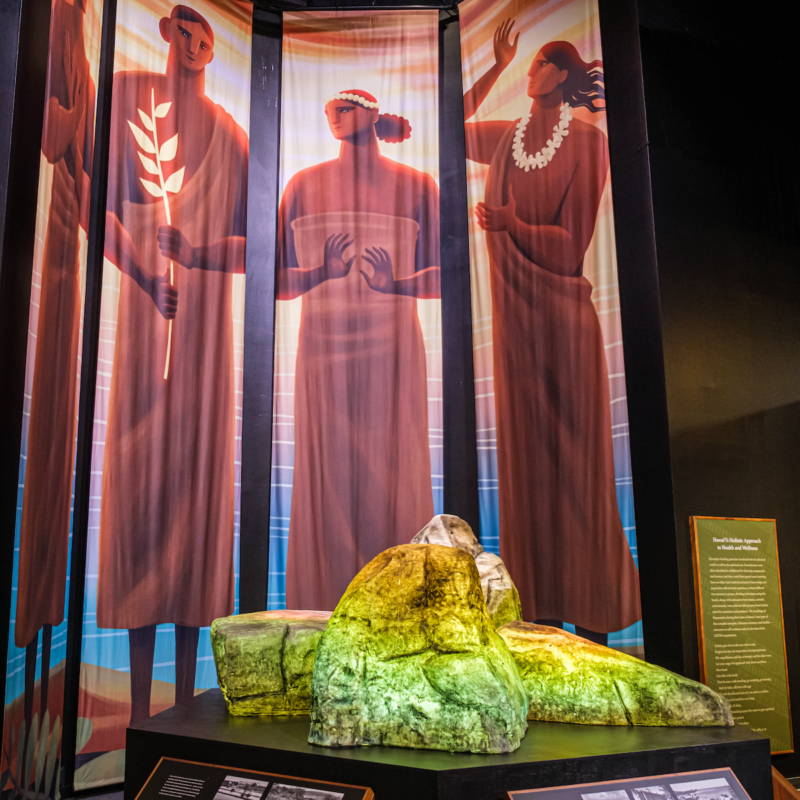Hawaii Museum Highlights Story Of Spiritual Waikiki Beach Stones Millions See Every Year
by Allison Godlove – Travel Awaits – July 4, 2022:

A new exhibit at The Bishop Museum reveals a long-hidden history of the mysterious stones on Waikīkī Beach, a storied site that few of the millions who pass it by know anything about. The Healer Stones of Kapaemahu explores the past and contemporary means of the four large stones and the legendary male and female healing spirits within them.
The Healer Stones of Kapaemahu were placed long ago on Waikīkī Beach to honor four māhū, extraordinary individuals of dual male and female spirit, who brought healing arts from Tahiti to Hawaiʻi. Although the stones have survived for centuries, the story behind them has been suppressed and the respected role of māhū erased.
Guests begin in the Castle Memorial Building with the life-size rendering of the stones and spirits in the main gallery, then watch their story unfold in a captivating animated film. Guests then continue from the theater to an enormous room lined with projection screens and are immersed in the long history of the site and its story.
“Our source for the definition of the term ‘Kapaemahu’ is Mary Kawena Pukui, the leading Hawaiian scholar of the 20th century who worked at Bishop Museum for much of her life. She gives this definition in the book she co-wrote, ‘Hawaiian Place Names,’” said DeSoto Brown, Bishop Museum historian, curator of archives, and exhibition lead curator. “In presenting the original moʻolelo from 500 or more years ago, and examining the ways in which it, and the monument erected to honor its heroes, were altered in the 20th century, The Healer Stones of Kapaemahu challenges visitors to ponder how other aspects of Hawaiian history and culture might have been suppressed, changed, or lost. More importantly, visitors will understand that these aspects of Hawaiian culture now have the opportunity to be restored and elevated.”

Highlights of The Healer Stones of Kapaemahu Exhibit
- Guests will experience an immersive theatrical experience of the 8-minute animated film, “Kapaemahu,” produced and directed by exhibition co-curators Dean Hamer, Joe Wilson, and Hinaleimoana Wong-Kalu.
- Large-scale, three-dimensional artistic renderings of the four pōhaku that constitute the cultural site of Kapaemahu.
- An Experiential Timeline gives an extensive multimedia presentation incorporating historical texts and audiovisual materials, spanning the time from the stones’ geological creation to the present day.
- Collection items selected for this exhibition speak to the integral role healing practices originally played at all levels of Kānaka Maoli life and how these became less prevalent through time due to foreign influences. Several key historical figures who contributed to the transmission of the Kapaemahu story over time will be shown in addition to an extensive array of photographs and historic film clips illustrating the dramatic changes to the Waikīkī district where the stones themselves are still seen today.
- A photo and video collage of Pacific Islanders self-representing their gender identities and other cultural heritages. This social media-driven component is collected and organized by Qwaves, LLC.
- One room of the exhibition is a salute to a famed Honolulu gathering place and nightspot of the 1960s and ’70s, where māhū performers could openly be themselves as well as earn a paycheck. The Glade show club functioned as a safe space in the face of hostility and legal prosecution from the rest of the world.

The mission of The Bernice Pauahi Bishop Museum is to inspire the community and visitors through the exploration, celebration, and perpetuation of the extraordinary history, culture, and environment of Hawai’i and the Pacific. It was founded in 1889 by Charles Reed Bishop in memory of his wife, Bernice Pauahi Bishop, a royal descendent of King Kamehameha I. Today, the museum is an educational center for the community and is widely regarded as the world’s premier institution for Hawaiian and Pacific content.
More than 200,000 people visit the museum each year, including 20,000 children on school visits. The museum is home to more than 25 million objects and specimens representing nine disciplines and includes more than 22 million biological specimens, over 2 million cultural objects, 115,000 historical publications, and 1 million photographs, films, works of art, audio recordings, and manuscripts.
The exhibit runs through October 16, 2022. Admission is free for members, $24.95 for adults, $21.95 for seniors, and $16.95 for those aged 4-17. To learn more about the Bishop Museum and the exhibit visit the museum’s website.